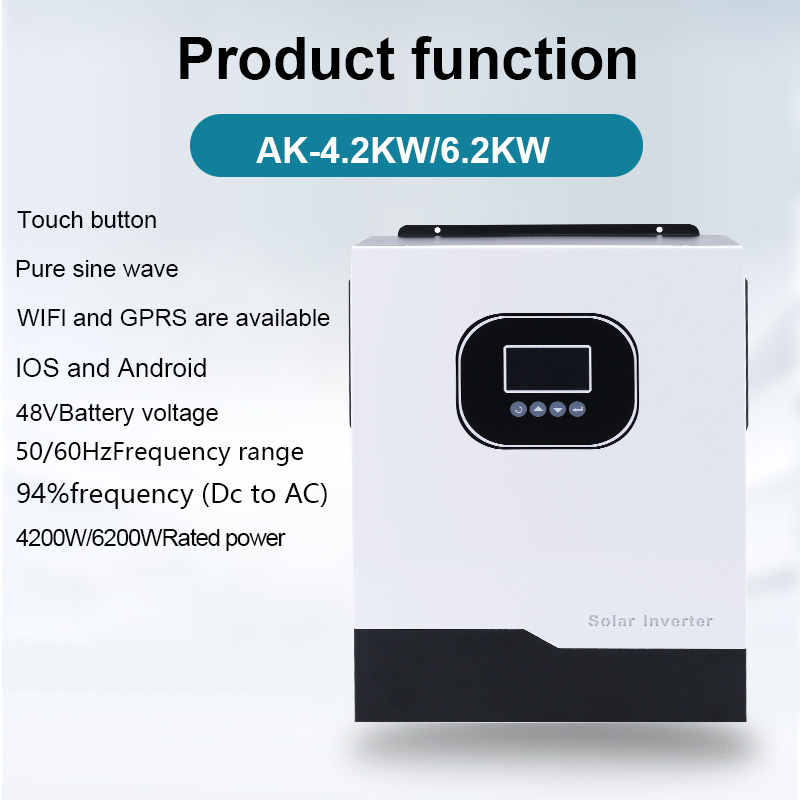Hybrid
Power Inverter, as a device that combines the functions of ordinary inverters and Lead Acid battery,
Lifepo4 Battery high frequency inverters, have a series of unique advantages and disadvantages. Here is a detailed analysis of its advantages and disadvantages:
advantage
High efficiency:
Hybrid inverters can smoothly switch between a variety of energy sources, such as solar generators, batteries, and municipal power supplies, thus significantly improving the efficiency of energy conversion. This efficient energy conversion mechanism helps reduce energy waste and improve the overall system energy efficiency.
Flexibility:
This type of inverter allows the use of a variety of energy inputs, such as solar energy, municipal power supplies, batteries, etc., and can flexibly choose different energy sources for power supply according to actual needs. This flexibility enables hybrid inverters to adapt to a variety of complex application scenarios and meet the diverse needs of different users.
Control:
Hybrid inverters are usually equipped with an independent control system and monitoring function to monitor key parameters such as energy flow, energy output and battery status in real time. Based on this real-time data, the inverter can automatically adjust the output and distribution of energy, ensuring stable operation and efficient performance of the system.
Wide range of application scenarios:
Hybrid inverters can play an important role in a variety of application scenarios such as home solar system, business
Solar Energy System, and agriculture. For example, in home applications, it can provide efficient, flexible and controllable power services for families, and store electrical energy through the function of battery inverters in emergencies to ensure household electricity demand. In commercial and agricultural applications, it can also integrate multiple energy sources, flexibly meet different electricity needs, and reduce resource costs.
Wide output voltage range:
The output voltage range of hybrid inverters is usually wide, generally 120V-350V, which makes it able to adapt to more kinds of load equipment, improve the compatibility and stability of the system.
Island protection function:
The hybrid inverter also has the island protection function, which can automatically disconnect from the power grid when the power grid fails to prevent the occurrence of island phenomenon. Although its island protection function may not be as tight as the off-grid inverter, it improves the security and reliability of the system to a certain extent.
shortcoming
Higher cost:
Compared with single-function inverters, hybrid inverters usually have higher manufacturing costs due to the integration of multiple functions and technologies. This could increase initial investment costs for users and limit its adoption in some low-cost applications.
Increased complexity:
The design and manufacturing process of hybrid inverters is relatively complex, requiring more technical investment and research and development costs. At the same time, its complex system structure and function may also increase the difficulty and cost of later maintenance.
Dependence on light intensity:
In some application scenarios, such as photovoltaic systems, the performance of hybrid inverters may be affected by the light intensity. When the light intensity is insufficient, the output voltage of the photovoltaic panel array will fluctuate in a large range, thus affecting the stability and efficiency of the inverter.
Security risks:
Although hybrid inverters have a variety of safety protection features, they can still cause safety hazards under extreme conditions (such as overcharge, over discharge, short circuit or high temperature). Therefore, in the process of use, it is necessary to strictly abide by the operating procedures and safety specifications to ensure the safe operation of the system.
In summary, hybrid inverters have significant advantages in terms of efficiency, flexibility, control, etc., but they also have disadvantages such as high cost, increased complexity, dependence on light intensity and security risks. In practical applications, comprehensive consideration and selection should be made according to specific requirements and scenarios.
| Model | KLW-AK-10.2KW |
| Stage | 1 phase |
| Max. PV input power | 10200W |
| Rated output power | 10200W/10200VA |
| Max solar charging current | 180A |
| PV input (DC) |
| Nominal DC voltage/ max. DC voltage | 360VDC/500VDC |
| Starting voltage/ initial feed voltage | 90VDC/120VDC |
| MPPT voltage range | 90VDC~450VDC |
| Number of MPPT tractors/ Max current | 1/27A |
| GRID OUTPUT (AC) |
| Nominal output voltage | 220/230/240VAC |
| Output voltage range | 195.5~253VAC |
| Nominal output current | 44.3A |
| Power factor | >0.99 |
| Feed into the grid frequency range | 49~51±1Hz |
| Efficiency |
| Max. Conversion efficiency (DC/AC) | 98% |
| Dual-load output power (V2.0) |
| Full load | 10200W |
| Max. Main load | 10200W |
| Max secondary load (battery mode) | 3400W |
| Main load cut-off voltage | 44VDC |
| Main load loop voltage | 48VDC |
| Off-grid operation |
| AC input |
| AC start voltage/ automatic restart voltage | 120-140VAC/180VAC |
| Acceptable input voltage range | 90-280VAC or 170-280VAC |
| Max. AC input current | 50A |
| Nominal operating frequency | 50/60Hz |
| Surge power | 20400W |
| PV input (DC) |
| Max. DC voltage | 500VDC |
| MPPT voltage range | 90VDC-450VDC |
| Num. Of MPPT trackers/ Max. current | 1/27A |
| Battery mode output (AC) |
| Nominal output voltage | 48VDC |
| Output waveform | Pure sine wave |
| Efficiency (DC to AC) | 94% |
| BATTERIES AND CHARGERS |
| Nominal DC voltage | 48VDC |
| Max. solar charging current | 180A |
| Max. AC charging current
| 160A |
| Dimension, D*W*H | 537*390*130 |
| Net weight (kgs) | 14.5kg |

Product Categories : Power Inverter






